This delicious, rustic sourdough bread is easy enough for the beginner baker to master, yet has complex enough flavors to impress family and friends! Made with three simple ingredients, it’s full of nutrients, easier to digest than other breads, has a low gluten content and glycemic index. With gut health in mind, this is a no brainer in our household!
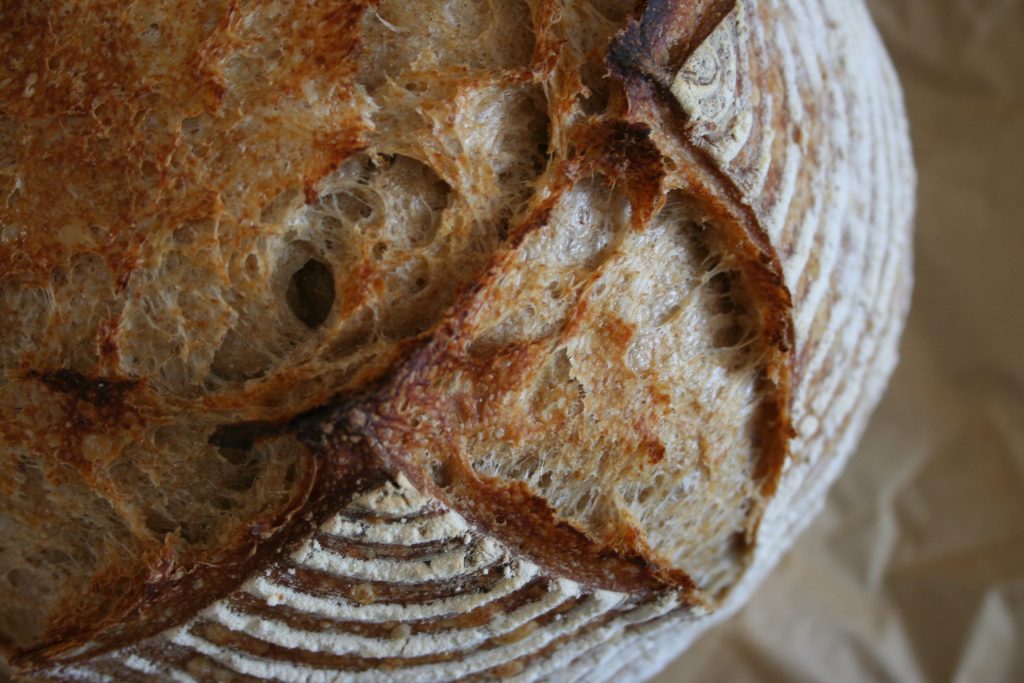
Basic sourdough bread is the first thing I learned how to bake using my homemade sourdough starter. The second thing I’ve quickly learned is that the process of making bread teaches you as much about yourself as it does about the bread, which I love! Patience and trusting the process are some major takeaways for me. The techniques used are more so of an art than a science, at least from my experience. Once I mastered the “beginner’s” sourdough, I wanted to experiment with other types of flour. This lead me to a “rustic” sourdough bread seen in this recipe.
So, about this recipe. Just like a “basic” sourdough, this rustic sourdough bread recipe calls for an active starter rather than commercial yeast. However, this recipe calls for whole wheat flour, and rye flour in addition to bread flour. The bread flour gives this sourdough loaf a good amount of protein content in order to have the gluten structure needed. The wheat and rye flour give great flavor without adding to the gluten content and the rye flour adds to the nutritional value of the bread. That alone has me sold!
Notes to Consider:
- Due to the wheat and rye flour, more water is needed than in a “basic” sourdough recipe.
- Loaves baked with rye will remain a bit more moist and soft for a longer period of time.
- The Rye flour will naturally give the loaf a slightly “gummy” texture more so than a basic all-purpose flour or bread flour recipe.
- When you feed your starter will determine when you bake your loaf. I have included a rough timeline for reference, but you can adjust it according to your needs.
Rustic Sourdough Bread Ingredients:
- 375g organic white bread flour or organic all-purpose flour
- 85g organic whole wheat flour
- 40g organic rye flour
- 375g filtered water (in order to eliminate chlorine and toxic chemicals I love and use the Aquatru water filter)
- 100g active sourdough starter
- 10g sea salt (I like Redmond’s Sea Salt because it’s certified organic, mined in the US, and contains 60+ trace minerals)
Rough Timeline and Step-by-Step Instructions:
- 10:30 pm: Feed sourdough starter in order to prepare it for the next morning. For more information on starting and maintaining a starter click here. I also like this video for learning how to make a starter. (The time you choose to feed your starter will depend on the time it takes it to reach its peak for use. This will change depending upon temperature, altitude, type of flour used, maturity of the starter, etc.)
- 7:30 am: Combine flour, water, starter and salt. Mix until a shaggy dough forms. You are looking for hydration of all of the flour at this stage, rather than shaping or strength to be built. Cover the dough with a damp towel.
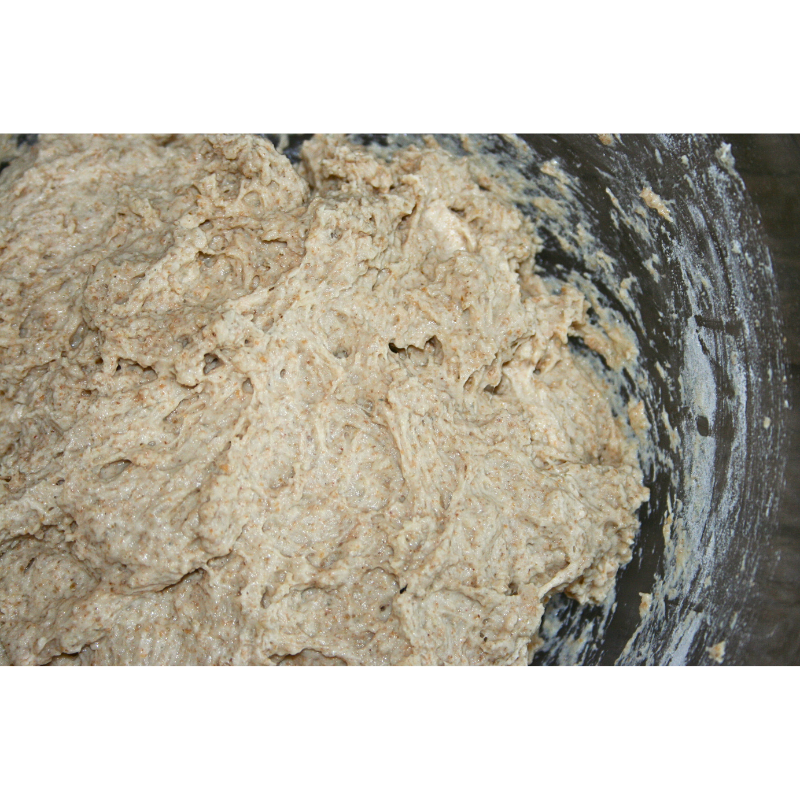
- 8:00 am: Begin your first stretch and fold. Wet your hands to avoid the dough sticking to them, grab one side of the dough and pull it up with a wiggling or bouncing motion, stretching it as far as it will go without tearing. Place into the center of the dough. Turn the bowl one quarter of the way and repeat this process. Complete this two more times. You will notice that your dough is no longer shaggy and is beginning to take on a smoother, more defined feel to it. Cover the dough.
- 8:30 am: Stretch and fold. Cover the dough.
- 9:00 am: Do the last stretch and fold. By this stage the dough should have built up strength and taken on a more defined shape. You know that you are ready for bulk fermentation when the dough passes the window pane test. To do the window pane test, take a golf ball sized chunk out of the dough, gently stretch it out between your fingers and try to get it as thin as you can without it tearing. If you can stretch it thin enough to see light through the dough and without significant tearing, you are likely ready to let the dough sit for the remainder of bulk fermentation. Cover the dough and let sit for at least 4 hours. This time may vary depending upon temperature, ripeness of the starter, altitude, etc. I check for the edges to be rounded away from the bowl, for bubbles on the top of the dough as well as visible through the sides of the dough, and for the dough to have risen as least 20-50%. (Note: be sure that your towel doesn’t dry out or you’ll end up with a hard crust that forms over the top of your dough).
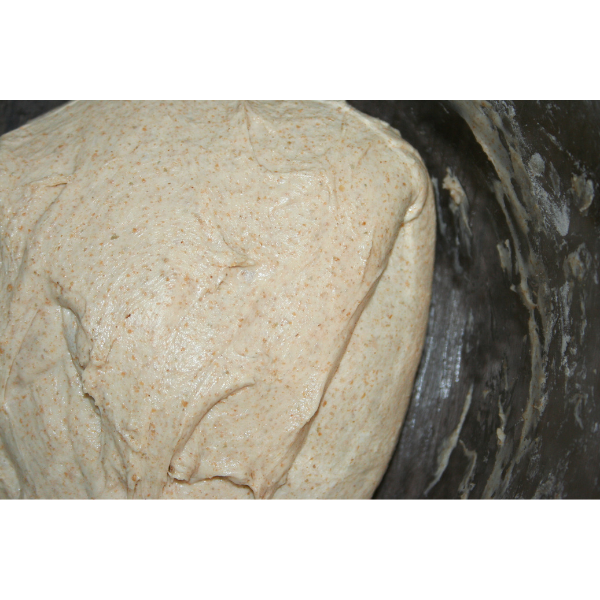
- 2:00 pm: Begin the pre-shaping process. Scoop the dough from the bowl onto the lightly floured counter and bring up the sides to create a ball with the seam on top. Then, gently begin shaping it into a ball by pulling and spinning it toward you (this helps create tension in the dough, creating a good oven spring). Let sit for about 15 minutes covered. (During this time you can generously coat your proofing basket with flour)
- 2:15 pm: Gently pull the edges and shape into a rectangle while being mindful not to pop the bubbles that we worked so hard to create. Bring up one side and fold it over the middle. Do the same with the other side. Then, fold like a jelly roll. Begin to shape into a ball and place into the proofing basket. Allow to proof about 1-1.5 hours at room temperature. You will know the dough has properly proofed when you stick a finger into the dough and it springs back slowly. If it springs back quickly allow it to proof longer.
- 3:45 pm: Place into the fridge anywhere from 8-24 hours. (I love the flexibility this gives!).
- 8:00 am the following day: Turn on the oven and allow the dutch oven to heat for one hour at 500F. Once the oven has heated pull the dough out of the fridge. Coat the dough with flour and flip onto a parchment paper covered plate. Just before placing the shaped dough into the dutch oven, score it to allow a predictable expansion pattern.
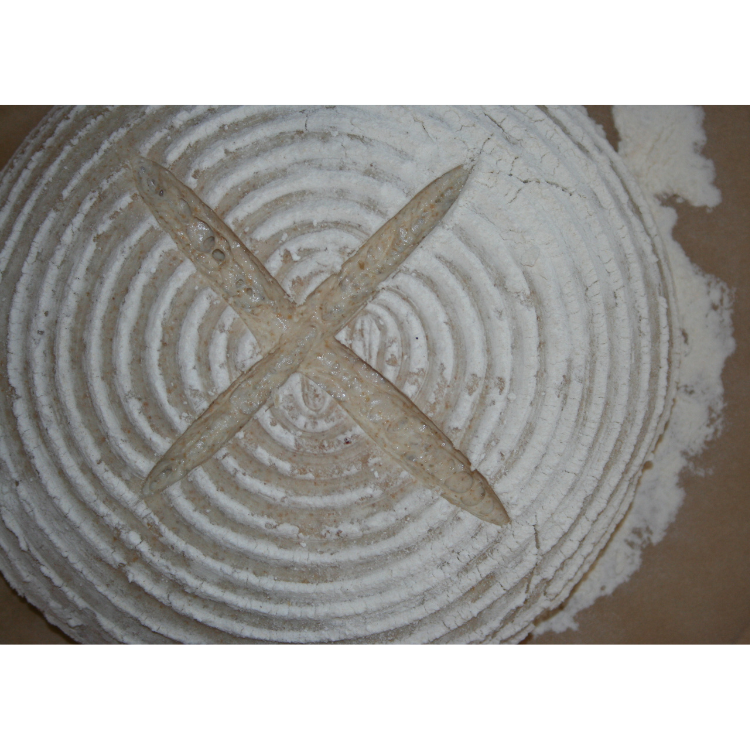
- 9:00 am: Place the sourdough loaf into the dutch oven with the lid on for 20 minutes.
- 9:20 am: After 20 minutes, lower the heat to 450F, carefully remove the lid and allow to bake for about 20-40 minutes. This time varies to allow you to reach the desired color.
- 9:50 am: Allow the loaf to cool for a few hours. And now enjoy your very own rustic sourdough bread!
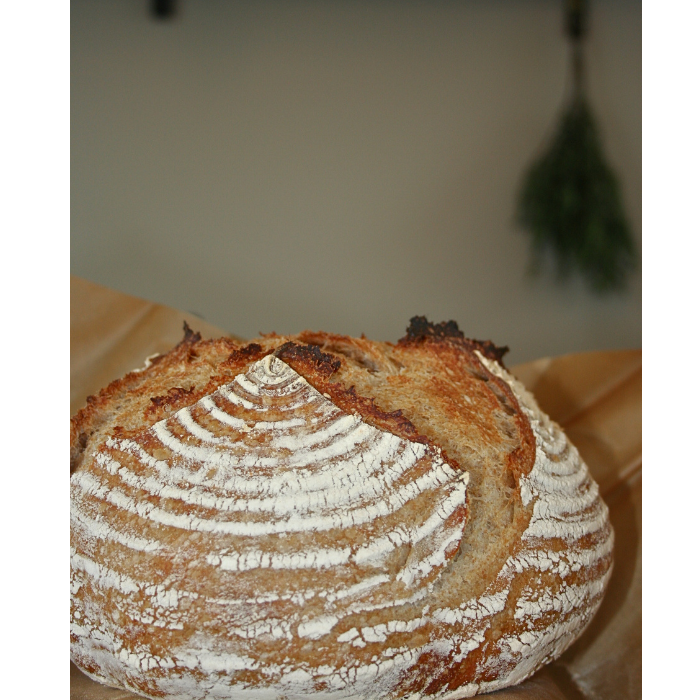
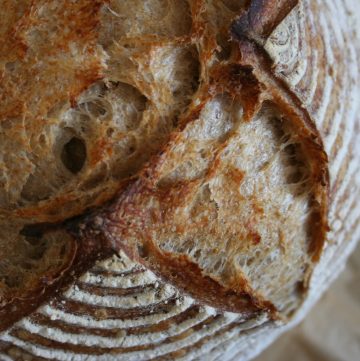
Rustic Sourdough Bread
Ingredients
- 375 g organic white bread flour or organic all-purpose flour
- 85 g organic whole wheat flour
- 40 g organic rye flour
- 375 g filtered water
- 100 g active starter
- 10 g sea salt (2tsp)
Instructions
- Feed sourdough starter in order to prepare it for the next morning. For more information on starting and maintaining a starter click here. I also like this video for learning how to make a starter. (The time you choose to feed your starter will depend on the time it takes it to reach its peak for use. This will change depending upon temperature, altitude, type of flour used, maturity of the starter, etc.)
- Combine flour, water, starter and salt. Mix until a shaggy dough forms. You are looking for hydration of all of the flour at this stage, rather than shaping or strength to be built. Cover the dough with a damp towel.
- Begin your first stretch and fold. Wet your hands to avoid the dough sticking to them, grab one side of the dough and pull it up with a wiggling or bouncing motion, stretching it as far as it will go without tearing. Place into the center of the dough. Turn the bowl one quarter of the way and repeat this process. Complete this two more times. You will notice that your dough is no longer shaggy and is beginning to take on a smoother, more defined feel to it. Cover the dough.
- Stretch and fold. Cover the dough.
- Do the last stretch and fold. By this stage the dough should have built up strength and taken on a more defined shape. You know that you are ready for bulk fermentation when the dough passes the window pane test. To do the window pane test, take a golf ball sized chunk out of the dough, gently stretch it out between your fingers and try to get it as thin as you can without it tearing. If you can stretch it thin enough to see light through the dough and without significant tearing, you are likely ready to let the dough sit for the remainder of bulk fermentation. Cover the dough and let sit for at least 4 hours. This time may vary depending upon temperature, ripeness of the starter, altitude, etc. I check for the edges to be rounded away from the bowl, for bubbles on the top of the dough as well as visible through the sides of the dough, and for the dough to have risen as least 20-50%. (Note: be sure that your towel doesn’t dry out or you’ll end up with a hard crust that forms over the top of your dough).
- Begin the pre-shaping process. Scoop the dough from the bowl onto the lightly floured counter and bring up the sides to create a ball with the seam on top. Then, gently begin shaping it into a ball by pulling and spinning it toward you (this helps create tension in the dough, creating a good oven spring). Let sit for about 15 minutes covered. (During this time you can generously coat your proofing basket with flour)
- Gently pull the edges and shape into a rectangle while being mindful not to pop the bubbles that we worked so hard to create. Bring up one side and fold it over the middle. Do the same with the other side. Then, fold like a jelly roll. Begin to shape into a ball and place into the proofing basket. Allow to proof about 1-1.5 hours at room temperature. You will know the dough has properly proofed when you stick a finger into the dough and it springs back slowly. If it springs back quickly allow it to proof longer.
- Place into the fridge anywhere from 8-24 hours. (I love the flexibility this gives!).
- Turn on the oven and allow the dutch oven to heat for one hour at 500F. Once the oven has heated pull the dough out of the fridge. Coat the dough with flour and flip onto a parchment paper covered plate. Just before placing the shaped dough into the dutch oven, score it to allow a predictable expansion pattern.
- Place the sourdough loaf into the dutch oven with the lid on for 20 minutes.
- After 20 minutes, lower the heat to 450F, carefully remove the lid and allow to bake for about 20-40 minutes. This time varies to allow you to reach the desired color.
- Allow the loaf to cool for a few hours. And now enjoy your very own rustic sourdough bread!
Notes
- Ensure that the sourdough starter is ripe and bubbly
- Be careful not to over ferment the dough
- You can play around with how long you bake your bread without the lid to achieve the desired color
- Let the bread cool completely in order to make it easier to slice and to avoid a gummy texture
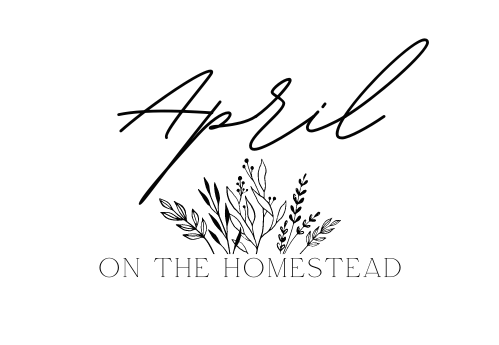
Leave a Reply